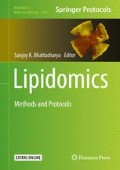Abstract
The compartmentalization of cellular membranes into discrete membrane microdomains (known as lipid rafts) challenged the original definition of membranes as containing randomly distributed lipid and protein components. The lipid microdomain hypothesis has generated significant controversy and rigorous inquiry based on the attractive idea that such domains concentrate machinery to mediate cellular events such as signaling and endocytosis. As such, numerous studies have used biochemical, cell biological, and biophysical methodologies to define the composition of such domains in a variety of experimental contexts. In this chapter, we describe methodologies to isolate membranes from cell or tissue sources with biophysical/biochemical properties of membrane microdomains that are amenable to subsequent classical or mass spectrometry-based lipid analytical approaches.
Access this chapter
Tax calculation will be finalised at checkout
Purchases are for personal use only
References
Singer SJ, Nicolson GL (1972) The fluid mosaic model of the structure of cell membranes. Science 175(4023):720–731
Lee AG, Birdsall NJ, Metcalfe JC, Toon PA, Warren GB (1974) Clusters in lipid bilayers and the interpretation of thermal effects in biological membranes. Biochemistry 13(18):3699–3705
Karnovsky MJ, Kleinfeld AM, Hoover RL, Klausner RD (1982) The concept of lipid domains in membranes. J Cell Biol 94(1):1–6
Simons K, Ikonen E (1997) Functional rafts in cell membranes. Nature 387(6633):569–572. doi:10.1038/42408
Pike LJ (2009) The challenge of lipid rafts. J Lipid Res 50(Suppl):S323–S328. doi:10.1194/jlr.R800040-JLR200
Munro S (2003) Lipid rafts: elusive or illusive? Cell 115(4):377–388
Sonnino S, Prinetti A (2013) Membrane domains and the "lipid raft" concept. Curr Med Chem 20(1):4–21
Pike LJ (2006) Rafts defined: a report on the keystone symposium on lipid rafts and cell function. J Lipid Res 47(7):1597–1598. doi:10.1194/jlr.E600002-JLR200
Brown DA, Rose JK (1992) Sorting of GPI-anchored proteins to glycolipid-enriched membrane subdomains during transport to the apical cell surface. Cell 68(3):533–544
Macdonald JL, Pike LJ (2005) A simplified method for the preparation of detergent-free lipid rafts. J Lipid Res 46(5):1061–1067. doi:10.1194/jlr.D400041-JLR200
Song KS, Li S, Okamoto T, Quilliam LA, Sargiacomo M, Lisanti MP (1996) Co-purification and direct interaction of Ras with caveolin, an integral membrane protein of caveolae microdomains. Detergent-free purification of caveolae microdomains. J Biol Chem 271(16):9690–9697
Smart EJ, Ying YS, Mineo C, Anderson RG (1995) A detergent-free method for purifying caveolae membrane from tissue culture cells. Proc Natl Acad Sci U S A 92(22):10104–10108
Elliott MH, Fliesler SJ, Ghalayini AJ (2003) Cholesterol-dependent association of caveolin-1 with the transducin alpha subunit in bovine photoreceptor rod outer segments: disruption by cyclodextrin and guanosine 5'-O-(3-thiotriphosphate). Biochemistry 42(26):7892–7903. doi:10.1021/bi027162n
Elliott MH, Nash ZA, Takemori N, Fliesler SJ, McClellan ME, Naash MI (2008) Differential distribution of proteins and lipids in detergent-resistant and detergent-soluble domains in rod outer segment plasma membranes and disks. J Neurochem 104(2):336–352. doi:10.1111/j.1471-4159.2007.04971.x
Martin RE, Elliott MH, Brush RS, Anderson RE (2005) Detailed characterization of the lipid composition of detergent-resistant membranes from photoreceptor rod outer segment membranes. Invest Ophthalmol Vis Sci 46(4):1147–1154. doi:10.1167/iovs.04-1207
Opreanu M, Tikhonenko M, Bozack S, Lydic TA, Reid GE, McSorley KM, Sochacki A, Perez GI, Esselman WJ, Kern T, Kolesnick R, Grant MB, Busik JV (2011) The unconventional role of acid sphingomyelinase in regulation of retinal microangiopathy in diabetic human and animal models. Diabetes 60(9):2370–2378. doi:10.2337/db10-0550
Ogiso H, Taniguchi M, Okazaki T (2015) Analysis of lipid-composition changes in plasma membrane microdomains. J Lipid Res 56(8):1594–1605. doi:10.1194/jlr.M059972
Seno K, Kishimoto M, Abe M, Higuchi Y, Mieda M, Owada Y, Yoshiyama W, Liu H, Hayashi F (2001) Light- and guanosine 5'-3-O-(thio)triphosphate-sensitive localization of a G protein and its effector on detergent-resistant membrane rafts in rod photoreceptor outer segments. J Biol Chem 276(24):20813–20816. doi:10.1074/jbc.C100032200
Ostrom RS, Liu X (2007) Detergent and detergent-free methods to define lipid rafts and caveolae. Methods Mol Biol 400:459–468. doi:10.1007/978-1-59745-519-0_30
Pike LJ, Han X, Gross RW (2005) Epidermal growth factor receptors are localized to lipid rafts that contain a balance of inner and outer leaflet lipids: a shotgun lipidomics study. J Biol Chem 280(29):26796–26804. doi:10.1074/jbc.M503805200
Lichtenberg D, Goni FM, Heerklotz H (2005) Detergent-resistant membranes should not be identified with membrane rafts. Trends Biochem Sci 30(8):430–436. doi:10.1016/j.tibs.2005.06.004
Lingwood D, Simons K (2007) Detergent resistance as a tool in membrane research. Nat Protoc 2(9):2159–2165. doi:10.1038/nprot.2007.294
Roper K, Corbeil D, Huttner WB (2000) Retention of prominin in microvilli reveals distinct cholesterol-based lipid micro-domains in the apical plasma membrane. Nat Cell Biol 2(9):582–592. doi:10.1038/35023524
Acknowledgments
This work was supported by NIH Grant R01EY019494, NIH Core Grant P30EY021725, and by an unrestricted grant from Research to Prevent Blindness, Inc. to the Department of Ophthalmology, University of Oklahoma Health Science Center.
Author information
Authors and Affiliations
Corresponding author
Editor information
Editors and Affiliations
Rights and permissions
Copyright information
© 2017 Springer Science+Business Media LLC
About this protocol
Cite this protocol
McClellan, M.E., Elliott, M.H. (2017). Analysis of Fatty Acid and Cholesterol Content from Detergent-Resistant and Detergent-Free Membrane Microdomains. In: Bhattacharya, S. (eds) Lipidomics. Methods in Molecular Biology, vol 1609. Humana Press, New York, NY. https://doi.org/10.1007/978-1-4939-6996-8_16
Download citation
DOI: https://doi.org/10.1007/978-1-4939-6996-8_16
Published:
Publisher Name: Humana Press, New York, NY
Print ISBN: 978-1-4939-6995-1
Online ISBN: 978-1-4939-6996-8
eBook Packages: Springer Protocols

